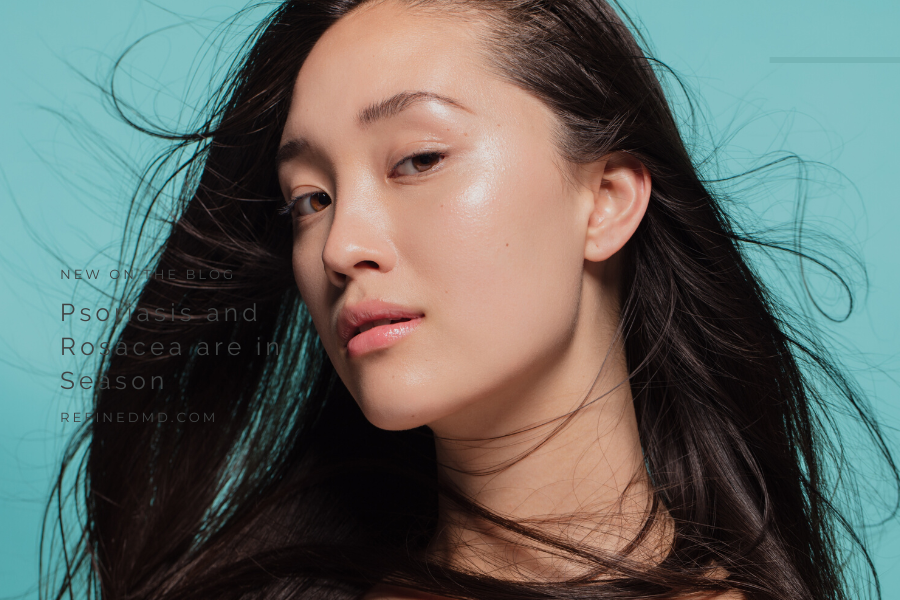
21 Feb Psoriasis and Rosacea are in Season
Rosacea is a common skin disorder that we often see at RefinedMD. It might begin as a slight blush but can quickly grow to an embarrassing and recurring flush. The redness can spread from the cheeks and nose all the way to the chin, forehead, and even the chest and back. Rosacea is often known as a “redness,” but there are several complementary symptoms it can also cause depending on the type of rosacea.
Erythematotelangiectatic rosacea presents as a redness and flushing, often with visible blood vessels. There’s also papulopustular rosacea with redness and swelling, but also with breakouts that look like acne. Phymatous rosacea is when the skin also thickens, and it may have bumps. Finally, ocular rosacea occurs around the eyes. It can swell the eyelids, make the eyes red and irritated, and you might think you have a sty. All four types of rosacea can cause a permanent redness at the center of the face. Fortunately, rosacea is treatable, and many people share your skin issue. Princess Diana, Bill Clinton, and WC Fields are just a few famous faces that have suffered from rosacea.
Fast Action
Identifying your type of rosacea is the first step in treatment. This chronic and inflammatory condition gets worse if untreated. However, it can be misdiagnosed as acne, skin allergies, or eczema. It’s most common in fair-skinned people and although the exact cause is unknown, some foods can make the symptoms worse (especially dairy and spicy food).
Once you have a correct diagnosis, medications and changes to your lifestyle can help keep symptoms at bay. Your dermatologist might prescribe a number of topical or oral medications such as oral antibiotics or topical treatments to help with redness. Laser treatments for visible blood vessels can be helpful, too. However, the first step is a proper diagnosis and you can get started by contacting our office.
What About Psoriasis?
There are five types of psoriasis, and each may be confused with other conditions (including rashes caused by allergies). At our clinic, a number of psoriasis treatments are available to offer patients relief and improve appearance. The most common sign that a rash is actually psoriasis is persistence. If you have a rash that doesn’t go away, it becomes inflamed, or begins to look like scales, it may be psoriasis.
The five types of psoriasis all have different causes, show different symptoms, and require different treatments. The most common type is plaque psoriasis. It shows up as red or pink raised lesions (plaques) and silver-colored scales. Plaque psoriasis can be itchy, cause soreness, and may bleed if scratched. Plaque psoriasis can happen anywhere, but is most common on elbows, knees, lower back, and the scalp. Treatment usually includes topical and oral medications and/or laser/light therapy.
The next most common type of psoriasis is guttate psoriasis. Around ten percent of psoriasis patients have this type of psoriasis. It looks like small, red sores usually on the trunk or limbs. The sores can look like dots, and many lesions have silver scales that are slimmer than plaque scales. Usually, children and young adults get this type of psoriasis, which can be triggered by bacterial infections.
Inverse psoriasis is most common in the armpits, genital area, behind the knees, below the breasts, and between the buttocks. There might be red patches, shiny and inflamed skin, but there are no scales. Soreness is common. Inverse psoriasis gets exacerbated in the summer and is most common in those who are overweight. Steroid cream is often recommended along with antifungal powders to keep the area dry.
Pustular psoriasis is rare, and usually occurs in adults. Patches may occur on hands, feet, or large areas on other parts of the body. The skin looks red, inflamed, and white pus-filled blisters may form. This type of psoriasis may be caused by medication withdrawal, infections, pregnancy, stress, or too much UV exposure. Oral medication and nutritional supplements may be prescribed.
The rarest type of psoriasis is erythrodermic psoriasis. Three percent of psoriasis patients have this type of psoriasis. When it occurs, over 75 percent of the body has a red rash that will peel in sheets. It is very itchy and painful, and requires hospitalization. Have you been diagnosed with psoriasis, or do you suspect you have it? Contact RefinedMD today to schedule a consultation and get relief—call our office or fill out the online form.
